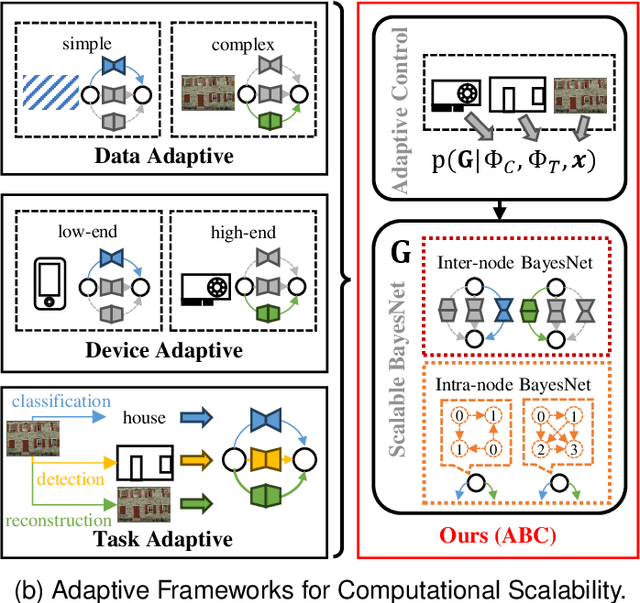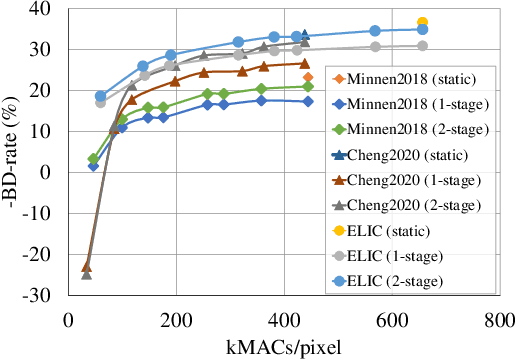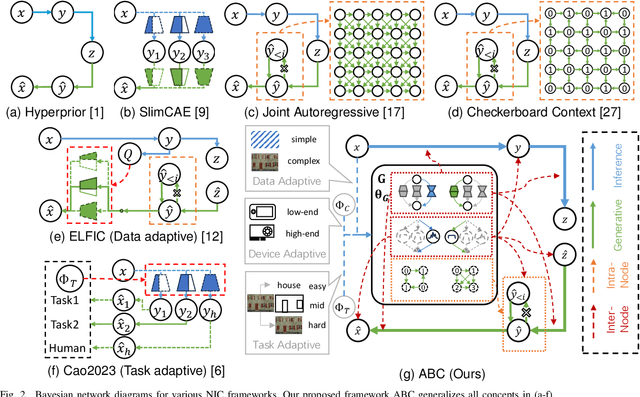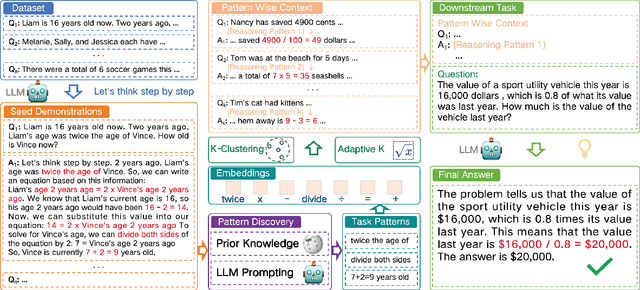Yufeng Zhang
School of Artificial Intelligence, Sun Yat-sen University, Zhuhai 519082, Guangdong Key Laboratory of Big Data Analysis and Processing, 510006, China
MCOP: Multi-UAV Collaborative Occupancy Prediction
Oct 14, 2025Abstract:Unmanned Aerial Vehicle (UAV) swarm systems necessitate efficient collaborative perception mechanisms for diverse operational scenarios. Current Bird's Eye View (BEV)-based approaches exhibit two main limitations: bounding-box representations fail to capture complete semantic and geometric information of the scene, and their performance significantly degrades when encountering undefined or occluded objects. To address these limitations, we propose a novel multi-UAV collaborative occupancy prediction framework. Our framework effectively preserves 3D spatial structures and semantics through integrating a Spatial-Aware Feature Encoder and Cross-Agent Feature Integration. To enhance efficiency, we further introduce Altitude-Aware Feature Reduction to compactly represent scene information, along with a Dual-Mask Perceptual Guidance mechanism to adaptively select features and reduce communication overhead. Due to the absence of suitable benchmark datasets, we extend three datasets for evaluation: two virtual datasets (Air-to-Pred-Occ and UAV3D-Occ) and one real-world dataset (GauUScene-Occ). Experiments results demonstrate that our method achieves state-of-the-art accuracy, significantly outperforming existing collaborative methods while reducing communication overhead to only a fraction of previous approaches.
ABC: Adaptive BayesNet Structure Learning for Computational Scalable Multi-task Image Compression
Jun 18, 2025



Abstract:Neural Image Compression (NIC) has revolutionized image compression with its superior rate-distortion performance and multi-task capabilities, supporting both human visual perception and machine vision tasks. However, its widespread adoption is hindered by substantial computational demands. While existing approaches attempt to address this challenge through module-specific optimizations or pre-defined complexity levels, they lack comprehensive control over computational complexity. We present ABC (Adaptive BayesNet structure learning for computational scalable multi-task image Compression), a novel, comprehensive framework that achieves computational scalability across all NIC components through Bayesian network (BayesNet) structure learning. ABC introduces three key innovations: (i) a heterogeneous bipartite BayesNet (inter-node structure) for managing neural backbone computations; (ii) a homogeneous multipartite BayesNet (intra-node structure) for optimizing autoregressive unit processing; and (iii) an adaptive control module that dynamically adjusts the BayesNet structure based on device capabilities, input data complexity, and downstream task requirements. Experiments demonstrate that ABC enables full computational scalability with better complexity adaptivity and broader complexity control span, while maintaining competitive compression performance. Furthermore, the framework's versatility allows integration with various NIC architectures that employ BayesNet representations, making it a robust solution for ensuring computational scalability in NIC applications. Code is available in https://github.com/worldlife123/cbench_BaSIC.
Detecting Emotional Incongruity of Sarcasm by Commonsense Reasoning
Dec 17, 2024Abstract:This paper focuses on sarcasm detection, which aims to identify whether given statements convey criticism, mockery, or other negative sentiment opposite to the literal meaning. To detect sarcasm, humans often require a comprehensive understanding of the semantics in the statement and even resort to external commonsense to infer the fine-grained incongruity. However, existing methods lack commonsense inferential ability when they face complex real-world scenarios, leading to unsatisfactory performance. To address this problem, we propose a novel framework for sarcasm detection, which conducts incongruity reasoning based on commonsense augmentation, called EICR. Concretely, we first employ retrieval-augmented large language models to supplement the missing but indispensable commonsense background knowledge. To capture complex contextual associations, we construct a dependency graph and obtain the optimized topology via graph refinement. We further introduce an adaptive reasoning skeleton that integrates prior rules to extract sentiment-inconsistent subgraphs explicitly. To eliminate the possible spurious relations between words and labels, we employ adversarial contrastive learning to enhance the robustness of the detector. Experiments conducted on five datasets demonstrate the effectiveness of EICR.
Seed-CTS: Unleashing the Power of Tree Search for Superior Performance in Competitive Coding Tasks
Dec 17, 2024Abstract:Competition-level code generation tasks pose significant challenges for current state-of-the-art large language models (LLMs). For example, on the LiveCodeBench-Hard dataset, models such as O1-Mini and O1-Preview achieve pass@1 rates of only 0.366 and 0.143, respectively. While tree search techniques have proven effective in domains like mathematics and general coding, their potential in competition-level code generation remains under-explored. In this work, we propose a novel token-level tree search method specifically designed for code generation. Leveraging Qwen2.5-Coder-32B-Instruct, our approach achieves a pass rate of 0.305 on LiveCodeBench-Hard, surpassing the pass@100 performance of GPT4o-0513 (0.245). Furthermore, by integrating Chain-of-Thought (CoT) prompting, we improve our method's performance to 0.351, approaching O1-Mini's pass@1 rate. To ensure reproducibility, we report the average number of generations required per problem by our tree search method on the test set. Our findings underscore the potential of tree search to significantly enhance performance on competition-level code generation tasks. This opens up new possibilities for large-scale synthesis of challenging code problems supervised fine-tuning (SFT) data, advancing competition-level code generation tasks.
Reward-Augmented Data Enhances Direct Preference Alignment of LLMs
Oct 10, 2024



Abstract:Preference alignment in Large Language Models (LLMs) has significantly improved their ability to adhere to human instructions and intentions. However, existing direct alignment algorithms primarily focus on relative preferences and often overlook the qualitative aspects of responses. Striving to maximize the implicit reward gap between the chosen and the slightly inferior rejected responses can cause overfitting and unnecessary unlearning of the high-quality rejected responses. The unawareness of the reward scores also drives the LLM to indiscriminately favor the low-quality chosen responses and fail to generalize to responses with the highest rewards, which are sparse in data. To overcome these shortcomings, our study introduces reward-conditioned LLM policies that discern and learn from the entire spectrum of response quality within the dataset, helping extrapolate to more optimal regions. We propose an effective yet simple data relabeling method that conditions the preference pairs on quality scores to construct a reward-augmented dataset. This dataset is easily integrated with existing direct alignment algorithms and is applicable to any preference dataset. The experimental results across instruction-following benchmarks including AlpacaEval, MT-Bench, and Arena-Hard-Auto demonstrate that our approach consistently boosts the performance of DPO by a considerable margin across diverse models. Additionally, our method improves the average accuracy on various academic benchmarks. When applying our method to on-policy data, the resulting DPO model achieves SOTA results on AlpacaEval. Through ablation studies, we demonstrate that our method not only maximizes the utility of preference data but also mitigates the issue of unlearning, demonstrating its broad effectiveness beyond mere dataset expansion. Our code is available at https://github.com/shenao-zhang/reward-augmented-preference.
BabelBench: An Omni Benchmark for Code-Driven Analysis of Multimodal and Multistructured Data
Oct 01, 2024



Abstract:Large language models (LLMs) have become increasingly pivotal across various domains, especially in handling complex data types. This includes structured data processing, as exemplified by ChartQA and ChatGPT-Ada, and multimodal unstructured data processing as seen in Visual Question Answering (VQA). These areas have attracted significant attention from both industry and academia. Despite this, there remains a lack of unified evaluation methodologies for these diverse data handling scenarios. In response, we introduce BabelBench, an innovative benchmark framework that evaluates the proficiency of LLMs in managing multimodal multistructured data with code execution. BabelBench incorporates a dataset comprising 247 meticulously curated problems that challenge the models with tasks in perception, commonsense reasoning, logical reasoning, and so on. Besides the basic capabilities of multimodal understanding, structured data processing as well as code generation, these tasks demand advanced capabilities in exploration, planning, reasoning and debugging. Our experimental findings on BabelBench indicate that even cutting-edge models like ChatGPT 4 exhibit substantial room for improvement. The insights derived from our comprehensive analysis offer valuable guidance for future research within the community. The benchmark data can be found at https://github.com/FFD8FFE/babelbench.
Robust Beamforming Design for Near-Field DMA-NOMA mmWave Communications With Imperfect Position Information
Sep 24, 2024



Abstract:For millimeter-wave (mmWave) non-orthogonal multiple access (NOMA) communication systems, we propose an innovative near-field (NF) transmission framework based on dynamic metasurface antenna (DMA) technology. In this framework, a base station (BS) utilizes the DMA hybrid beamforming technology combined with the NOMA principle to maximize communication efficiency between near-field users (NUs) and far-field users (FUs). In conventional communication systems, obtaining channel state information (CSI) requires substantial pilot signals, significantly reducing system communication efficiency. We propose a beamforming design scheme based on position information to address with this challenge. This scheme does not depend on pilot signals but indirectly obtains CSI by analyzing the geometric relationship between user position information and channel models. However, in practical applications, the accuracy of position information is challenging to guarantee and may contain errors. We propose a robust beamforming design strategy based on the worst-case scenario to tackle this issue. Facing with the multi-variable coupled non-convex problems, we employ a dual-loop iterative joint optimization algorithm to update beamforming using block coordinate descent (BCD) and derive the optimal power allocation (PA) expression. We analyze its convergence and complexity to verify the proposed algorithm's performance and robustness thoroughly. We validate the theoretical derivation of the CSI error bound through simulation experiments. Numerical results show that our proposed scheme performs better than traditional beamforming schemes. Additionally, the transmission framework exhibits strong robustness to NU and FU position errors, laying a solid foundation for the practical application of mmWave NOMA communication systems.
Pattern-Aware Chain-of-Thought Prompting in Large Language Models
Apr 23, 2024



Abstract:Chain-of-thought (CoT) prompting can guide language models to engage in complex multi-step reasoning. The quality of provided demonstrations significantly impacts the success of downstream inference tasks. While existing automated methods prioritize accuracy and semantics in these demonstrations, we show that the underlying reasoning patterns play a more crucial role in such tasks. In this paper, we propose Pattern-Aware CoT, a prompting method that considers the diversity of demonstration patterns. By incorporating patterns such as step length and reasoning process within intermediate steps, PA-CoT effectively mitigates the issue of bias induced by demonstrations and enables better generalization to diverse scenarios. We conduct experiments on nine reasoning benchmark tasks using two open-source LLMs. The results show that our method substantially enhances reasoning performance and exhibits robustness to errors. The code will be made publicly available.
A Mean-Field Analysis of Neural Gradient Descent-Ascent: Applications to Functional Conditional Moment Equations
Apr 18, 2024Abstract:We study minimax optimization problems defined over infinite-dimensional function classes. In particular, we restrict the functions to the class of overparameterized two-layer neural networks and study (i) the convergence of the gradient descent-ascent algorithm and (ii) the representation learning of the neural network. As an initial step, we consider the minimax optimization problem stemming from estimating a functional equation defined by conditional expectations via adversarial estimation, where the objective function is quadratic in the functional space. For this problem, we establish convergence under the mean-field regime by considering the continuous-time and infinite-width limit of the optimization dynamics. Under this regime, gradient descent-ascent corresponds to a Wasserstein gradient flow over the space of probability measures defined over the space of neural network parameters. We prove that the Wasserstein gradient flow converges globally to a stationary point of the minimax objective at a $\mathcal{O}(T^{-1} + \alpha^{-1} ) $ sublinear rate, and additionally finds the solution to the functional equation when the regularizer of the minimax objective is strongly convex. Here $T$ denotes the time and $\alpha$ is a scaling parameter of the neural network. In terms of representation learning, our results show that the feature representation induced by the neural networks is allowed to deviate from the initial one by the magnitude of $\mathcal{O}(\alpha^{-1})$, measured in terms of the Wasserstein distance. Finally, we apply our general results to concrete examples including policy evaluation, nonparametric instrumental variable regression, and asset pricing.
Super-resolution of biomedical volumes with 2D supervision
Apr 15, 2024



Abstract:Volumetric biomedical microscopy has the potential to increase the diagnostic information extracted from clinical tissue specimens and improve the diagnostic accuracy of both human pathologists and computational pathology models. Unfortunately, barriers to integrating 3-dimensional (3D) volumetric microscopy into clinical medicine include long imaging times, poor depth / z-axis resolution, and an insufficient amount of high-quality volumetric data. Leveraging the abundance of high-resolution 2D microscopy data, we introduce masked slice diffusion for super-resolution (MSDSR), which exploits the inherent equivalence in the data-generating distribution across all spatial dimensions of biological specimens. This intrinsic characteristic allows for super-resolution models trained on high-resolution images from one plane (e.g., XY) to effectively generalize to others (XZ, YZ), overcoming the traditional dependency on orientation. We focus on the application of MSDSR to stimulated Raman histology (SRH), an optical imaging modality for biological specimen analysis and intraoperative diagnosis, characterized by its rapid acquisition of high-resolution 2D images but slow and costly optical z-sectioning. To evaluate MSDSR's efficacy, we introduce a new performance metric, SliceFID, and demonstrate MSDSR's superior performance over baseline models through extensive evaluations. Our findings reveal that MSDSR not only significantly enhances the quality and resolution of 3D volumetric data, but also addresses major obstacles hindering the broader application of 3D volumetric microscopy in clinical diagnostics and biomedical research.
 Add to Chrome
Add to Chrome Add to Firefox
Add to Firefox Add to Edge
Add to Edge